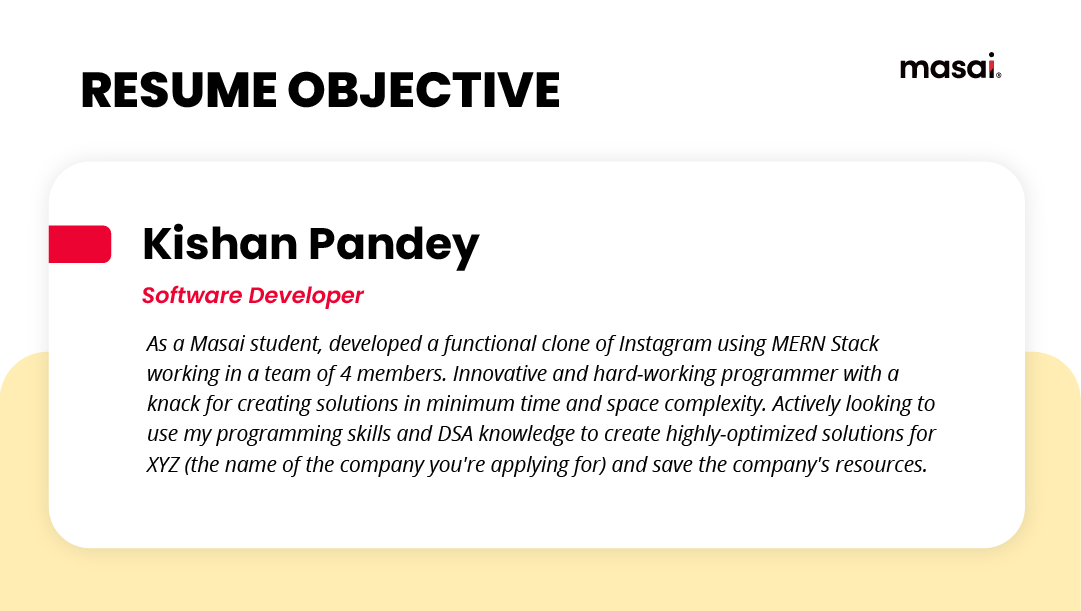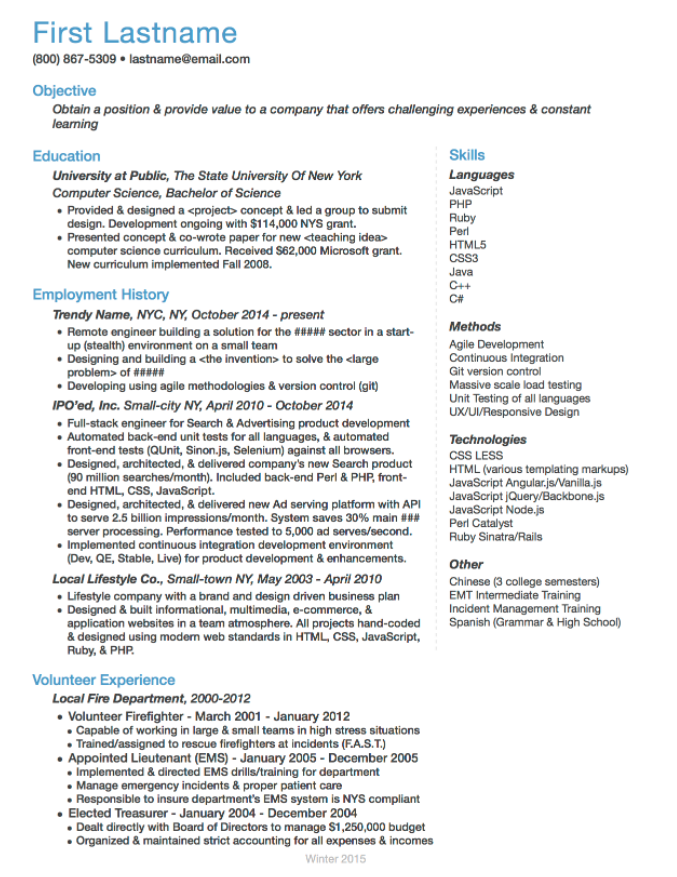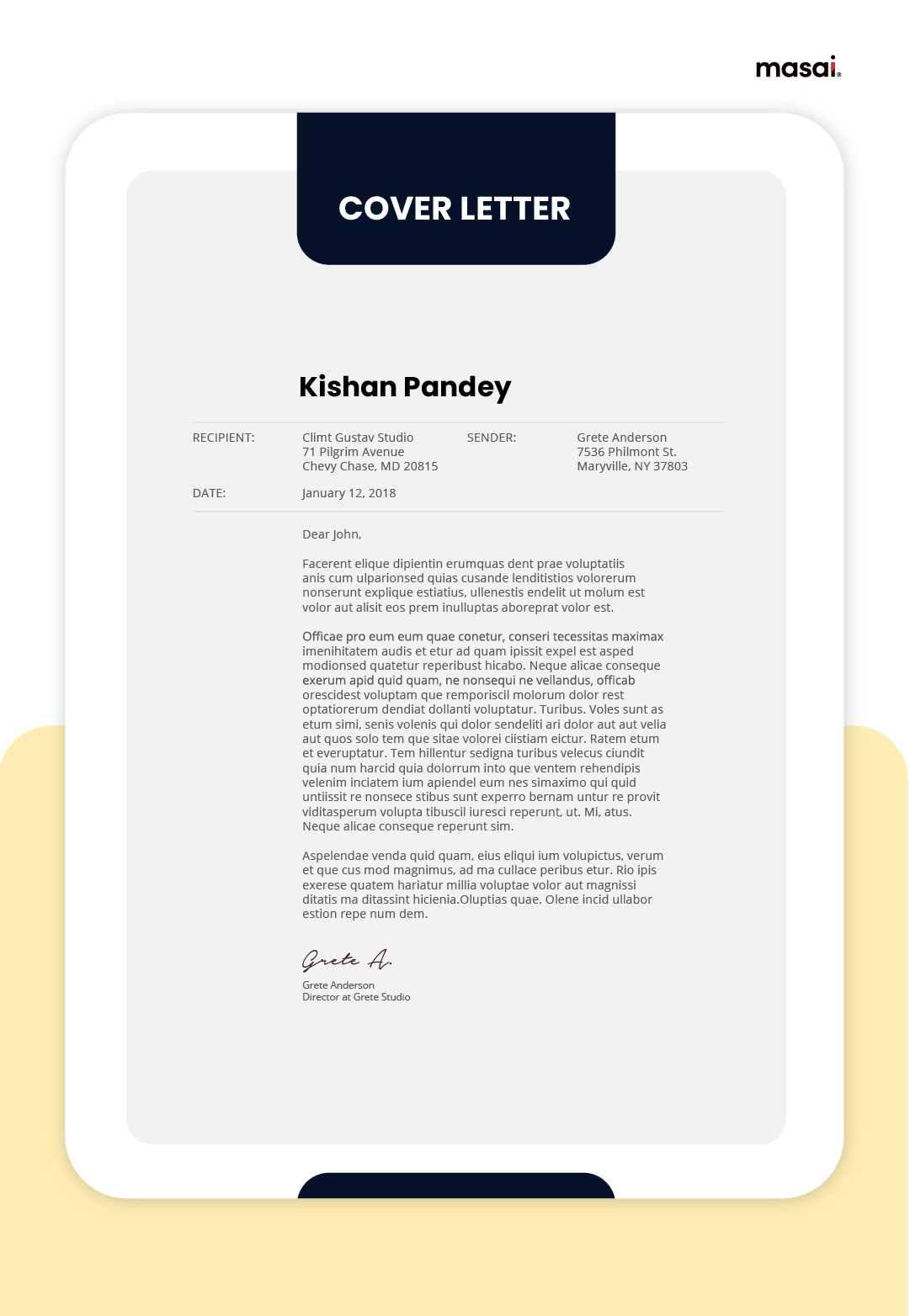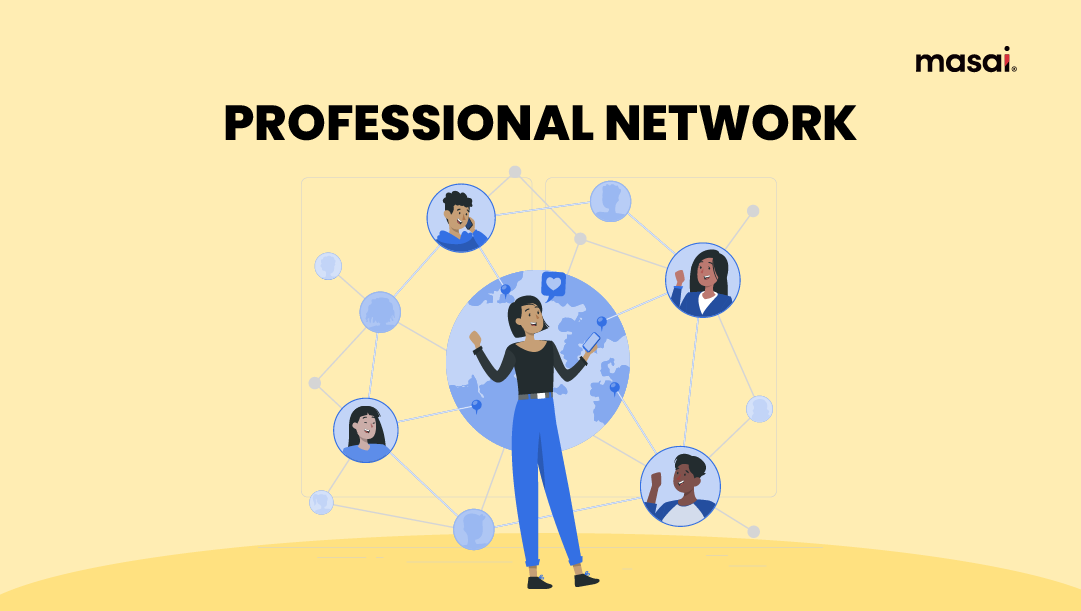Web Developer Resume that will Get You Hired
Mark the responsibilities of the role you're applying for while reading the job description. Pick out the important keywords and incorporate them into your resume.

Getting noticed by an employer is as important as standing out from the crowd in competition. Read about how you can improve your chances of getting hired with some helpful resume tips.
Your resume is your identity to a recruiter. They will see your CV even before they see you. So, let's make sure it makes you stand out!
You've learned programming, done the hard yards, and even built projects. Now what? You want to work for a good company. But that's exactly what a thousand other developers want as well. How do you get there? How do you get through the company's door and bag that million-dollar job? (literally in a few cases)
Even before starting on a resume, we must tell you that there are known ways that are considered better, and faster than resumes - What you ask?
- A personal brand, or proof of work that's open for anyone, and everyone to access.
- Developers with a good presence on GitHub or other competitive profiles are said to receive 100s of offers in months.
- GitHub Profile or Competitive Programming profile stand better engagement ratio as employers would any day prefer a live demonstration of your abilities.
But in case, you don't have a solid presence in these domains, you must have a solid resume to make you stand out in the sea of resumes on the hiring manager's desk.
Resume Objective

Imagine your programming recruiter/hiring manager is sitting at his desk with 100s of resumes for an entry-level job. He's giving 5-10 seconds to each resume and putting them on the sidelines. Suddenly, he comes across yours and he springs upon his seat. And he reads the whole thing.
How can your resume grab such attention?
Well, it can do so if you have crafted a 2-3 lines introduction at the top that shows why you're the best fit for the role. To hold his attention span, you need to clarify the objective in the first 5 seconds. A brief introduction will be able to keep his interest and he will most probably go through your entire resume. Using this simple objective will separate your resume from 9 out of 10 other resumes.
How to write a resume objective?
- Focus on what the employer needs from you
- Summarise how your skills match the exact requirements
- Convey how you'll bring better results to the company
Example of a normal/not-so-good resume-
"Computer Science B Tech graduate seeking a challenging position in a reputable organization where I can leverage my skills in front-end development and work in team-environment to grow and achieve my career goals"
After reading this, the recruiter is more likely to sideline the resume in the first 10 seconds.
Here's a good example of an effective resume objective-
As a Masai student, developed a functional clone of Instagram using MERN Stack working in a team of 4 members. Innovative and hard-working programmer with a knack for creating solutions in minimum time and space complexity. Actively looking to use my programming skills and DSA knowledge to create highly-optimized solutions for XYZ (the name of the company you're applying for) and save the company's resources.
Easy to scan
How would the recruiter focus on your resume if it looks like a written mess?
Here are a few ways you can make it look easily scannable and convey the needed information in style -
- Use the reverse-chronological order
In a reverse chronological resume, you list your work experience (education experience if you're a recent grad) starting with the latest one at the top, and the rest followed in that order.
Jobvite did research and it came to light that 92% of recruiters/hiring managers consider previous work experience as the number one hiring factor.
If that's the case, why not serve that first on the plate and get the reader's attention from the get-go.
- Use bold text to convey important information -
For example - Information that matches the job requirement like the tech stack, tools, etc.
Once you're done assembling your work experience in one place, you need to tailor the content using appropriate action verbs.
How to customize your resume
Mark the responsibilities of the role you're applying for while reading the job description. Pick out the important keywords and if you see things you've done in your previous experiences, list them using bullet points under each experience.
For example - If the job description reads like this:
- Designing and developing internal projects including application development and migrations.
- Debug code for existing programs based on immediate need
- Implement systems in an in-house production environment
- Communicate design requirements for projects in writing and in meetings.
An effective resume that'll hit the home run would be :
- Designed and developed 8 application projects in one year
- Participated in project meetings with the design and data analysis teams.
- Reviewed and debugged code for existing internal programs.
What if you are a fresher?
You can always boost your resume with some freelance projects to show the employers that you have relevant work experience.
- Find freelance projects
- Participate in Competitive Programming (Here's a guide to getting started with competitive programming)
- Contribute to Open Source Projects. (Learn about open-source projects)
Next, add a good list of programming projects below the work experience/education section. Keep in mind the projects should be relevant to the job requirements.
Even if you don't have ample projects under your name, you can add the projects you built in your college/Bootcamp as they can work pretty well for an entry-level role.
Add a section for languages & technologies
List out the tools and technologies you've learned or you're proficient in.
As a developer, you'd have worked on various technologies for different projects. Time to highlight them under a separate section, so recruiters can know straightaway. Again, it'd be better if you tailor those skills in accordance with the job description.
Even if you're a fresher you can list what languages and tools you've learned.
Here's an example -
- Languages - JavaScript, HTML/CSS, SQL,
- Technologies - React.js, Node.js and Express.js, MongoDB
- Other - Data Structures and Algorithms, Routing and Advanced APIs, Redux and Hooks.
References - Here’s an example where the candidate has prioritized education over experience and has also put in a concise objective-

Cover letter
Do you know what else can accentuate your job application? - attaching a cover letter to your resume.
Large companies might not need one but if you're applying for a startup or a growing tech firm, cover letters work like a charm.

They convey the information in a creative way and give the recruiters more insight into your thought process and why exactly would you be the best fit for the company.
Since you people only believe in numbers, here's one for you -
A cover letter increases the chance of your job application being considered by a staggering 81%.
At this point, we shouldn't even be having any second thoughts about including a beautifully crafted cover letter to boost your chances.
Tips for writing a cover letter
• Keep it precise and relevant
• Add additional details about yourself other than the things you've mentioned on the resume
• Explain why you're a good fit for the role.
Want to create one? Head on to this cover letter builder here.
When it comes to job applications, few elements hold as much importance as the creation of an impactful cover letter. This document serves as a platform to exhibit your qualifications, skills, work history, and more. To assist you in this endeavor, consider these valuable tips:
Research the Company:
Begin by researching the company you're applying to. Understand its culture, values, and the specific job requirements. Tailor your cover letter to be in line with the company's needs and ethos.
Address the Hiring Manager:
Whenever possible, address the cover letter to the exact concerned person rather than using a generic salutation like "To Whom It May Concern." This demonstrates your effort and personalizes the letter.
Start Strong:
Begin with a strong and engaging opening paragraph. State the position you're applying for and briefly mention why you're excited about it or how you heard about the job.
Highlight Relevant Skills and Experience:
In the body of the letter, emphasize your qualifications, skills, and experience that are relevant to the job. Use specific examples to demonstrate your abilities.
Quantify Achievements:
Use numbers and data to quantify your accomplishments wherever possible. For example, "Increased sales by 20% in the first quarter" is more impactful than "Improved sales."
Show Enthusiasm:
Express your enthusiasm for the role and the company. Explain why you're a great fit and how your skills match with the company's goals and mission.
Customize Each Letter:
Avoid using a generic cover letter for multiple job applications. Tailor each letter to the specific job description and company.
Address Employment Gaps:
If you have gaps in your employment history, briefly address them in a positive light. For instance, explain how you used that time for skill development or volunteering.
Keep it Concise:
A cover letter should be crisp and to the point. Aim for three to four paragraphs, with each paragraph having a specific purpose.
Use Professional Language:
Maintain a professional tone throughout the letter. Avoid jargon and informal language. Proofread carefully for grammar and spelling errors.
Close Strong:
In your closing paragraph, reiterate your interest in the position and company. Express your desire for an interview and thank the reader for their time and consideration.
Signature and Contact Information:
Include a professional closing, such as "Sincerely," followed by your typed name. Below your name, provide your contact information, including phone number and email address.
Follow Up:
Mention in your closing that you'll follow up on your application. This shows your proactive approach to the job search.
Formatting and Style:
Use a clean and professional format. Stick to a standard font and ensure readability. Use bullet points or bold text for key points.
Proofread and Edit:
Before sending your cover letter, proofread it carefully. Consider having someone else review it as well to catch any errors or provide feedback.
Remember that a well-crafted cover letter can set you apart from other candidates and make a positive impression on potential employers. It's your opportunity to showcase your qualifications and enthusiasm, so invest time and effort into creating a strong one for each job application.
Grow your Professional Network

This shouldn't be a surprise in today's world where people from all domains are building their personal brands. Why should developers be left behind?
Growing your network gives you more chances of employee referrals that can instantly bring you to employers' notice.
Apart from building physical connections with techies from other companies, keep your LinkedIn profile up to date with the tools and technologies you have experience with. Share relevant content and build authority.
Create GitHub READMEs for every project that you upload on GitHub. READMEs summarise what your project is all about and gives viewers much-needed insight. Hiring managers always keep an eye on these platforms to recruit the best talents for their organization. So, be there
Now, as we mentioned in the beginning, applying for jobs and submitting resumes are not the only way to crack developer jobs.
For example - Top Indian competitive programmers like Rahul Dugar and Rajat De have established so much authority in the programming world that they’d be getting offers left, right, and center every day from top tech companies.
Similarly, top coding YouTubers like Akshay Saini (Namaste JavaSacript) and Harry (Code With Harry) have built their personal brands in the programming domain. They’ll surely have a competitive advantage if they wish to apply for jobs in top companies as their brands speak for themselves.
We hope you’ve gotten the gist of what an effective developer resume should look like.
Here are a few Do’s and Donts to summarise this article and help you build a resume that’ll get you hired.
Do's in a resume
- Do include a resume objective on the top.
- Customize your skills & work experiences according to the job profile.
- Use an easy-to-scan format.
- Do include a cover letter for more impact.
- Try to keep the resume to one page.
Dont's in a resume
- Don’t add irrelevant skills or experiences.
- Don’t use passive voice on your resume.
- Don’t try to hide educational or other gaps.
- Don’t go overboard describing yourself with cliche words. Keep it simple.
- And the most obvious but understated tip- Grammatical errors are a big no-no. Make sure you proofread it or use Grammarly for the same.
Even before building a resume, comes the part where you build real-world skills. And that’s where Masai stands strong, training students with industry-relevant developer skills and providing them with ample placement opportunities at the end of the program.
Want to know more?
Check out these full-time and part-time courses in web development and data analytics and start building your dream career.

